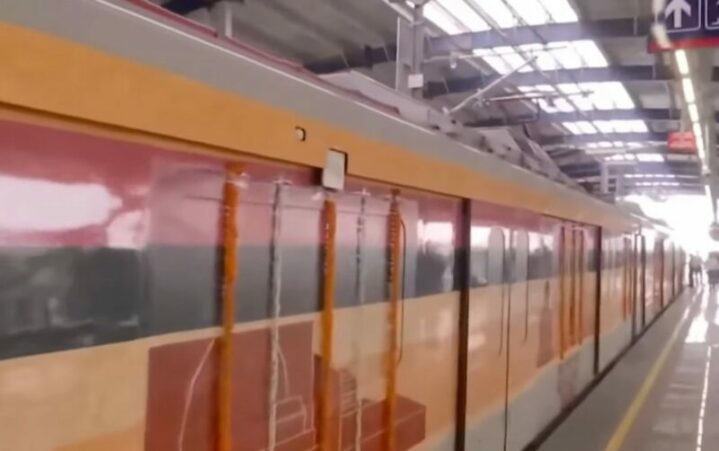
On October 7, 2025, Patna experienced a momentous event in its transportation history as the city’s first-ever metro train service commenced operations. The launch marked a significant milestone in Bihar’s growing urban infrastructure and brought excitement and pride to its residents. For years, Patna had dreamed of having a metro system to ease its traffic congestion and modernize its transport network, and on this day, that dream became a reality.
The Patna Metro, launched by the Patna Metro Rail Corporation (PMRC), began operations with much fanfare and celebrations. The day saw families, students, and the elderly coming out in large numbers to witness and experience the city’s first metro ride. The vibrant atmosphere at the stations reflected the city’s enthusiasm for the new mode of transportation, which promises to transform urban mobility in Patna.
Inaugural Day: A Grand Start to a New Era
From the very first hour of operation, the Patna Metro captured the attention of the city’s residents. At each station, passengers were greeted with festive excitement. Many were dressed as if attending a special event, with smiles and anticipation evident on their faces. The metro’s inaugural stretch, covering a 4.3 km route between New ISBT (Inter State Bus Terminal) and Bhootnath, was buzzing with activity, with packed platforms and passengers eager to board the sleek, air-conditioned trains.
By the end of the first day, the metro system had exceeded expectations. According to officials from PMRC, nearly 5,000 passengers had used the metro on Day One. The ticket sales amounted to Rs 80,000, reflecting the enthusiasm and demand for the service. For many, the metro ride was not just about getting from point A to point B, but a celebration of Patna’s urban transformation.
A Day of Celebration for Patna’s Residents
For residents like Aarti Kumari, who lives near Bhootnath Road, the experience was nothing short of thrilling. “I brought my children, and they really enjoyed it,” she said, her excitement palpable. “This feels like a new beginning for Patna. I’ll now use the metro instead of autos — it’s clean, comfortable, and peaceful.” Aarti’s sentiment was echoed by many others, who felt that the metro offered a much-needed upgrade to Patna’s public transport system.
The excitement was palpable, particularly among children who marveled at the modern trains. The smooth, air-conditioned ride offered a sharp contrast to the city’s often chaotic traffic, and it was clear that the metro had quickly become a symbol of Patna’s progress.
Shanti Devi, a resident of Rajendra Nagar, found the experience emotional as well as practical. “I never imagined I’d travel in a metro in my lifetime,” she said with a broad smile. “Now I can easily go to the Pataliputra bus stand without worrying about traffic jams.” For many older citizens, this day was not just about convenience but a realization that Patna was now part of the larger wave of modernization sweeping across Indian cities.
A Diverse Crowd on Day One: Families, Elderly, and Youngsters Join the Ride
The metro’s debut day saw a diverse crowd. From young students to elderly citizens like Bijendra Yadav, 65, from Pahadi, the metro provided a new and exciting form of transportation. “We had only heard of metros in big cities,” Bijendra said, beaming with joy after his first ride. “It feels special to have one here now. The government has done something truly good for the people.” For many elderly passengers, the metro provided a comfortable and safe way to travel around Patna, which was once limited to crowded buses and auto-rickshaws.
The excitement of the day was not limited to the novelty of the metro service itself. For Patna’s residents, it symbolized a long-awaited leap into modernity. As one passenger put it, “This is not just a train. It’s Patna moving forward.”
Operational Details and Management of the Patna Metro
Despite the large turnout, the metro operated smoothly, thanks to the professional management and planning by the Patna Metro Rail Corporation. The metro began its service at 8 a.m. and gradually picked up pace throughout the day. Initially, there was a modest crowd, but by mid-morning, the metro was running at full capacity. Passengers praised the cleanliness, safety, and modern amenities, which created a seamless and pleasant experience.
The ticket price for a ride was Rs 15, and passengers had the option to pay either in cash or through UPI. However, there were some instances of passengers receiving fines for exceeding the 45-minute time limit for exiting stations. Many such cases were reported at the Bhootnath station, where commuters struggled to get familiar with the new system.
Safety and Security Measures on Patna Metro
Security was a top priority for the Patna Metro on its first day of operation. Tight security measures were implemented at all three operational stations, with personnel from the Bihar Special Armed Police (BSAP) deployed to manage entry points and ensure passenger safety. BSAP personnel had undergone extensive training in Delhi and Chhattisgarh over the past two months, preparing them to handle emergencies and potential threats.
In addition to the BSAP personnel, private security agencies were enlisted to support station management. Trained staff from Delhi were stationed at ticket counters and customer service desks in two shifts, ensuring smooth operations and assisting passengers with any queries or concerns. The presence of trained staff ensured that passengers felt safe and well taken care of, especially in the early stages of the metro’s operation.
The Future of Urban Transport in Bihar: Patna Metro’s Impact
The successful launch of the Patna Metro marks the beginning of a new chapter in Bihar’s urban development. With modern urban transport infrastructure, Patna has joined the ranks of other Indian cities that are embracing metro systems as a solution to their growing transportation challenges. The introduction of the metro not only promises to improve connectivity but also represents a significant leap in the city’s infrastructure and economic growth.
For Patna’s residents, the metro is more than just a new mode of transport — it is a symbol of the city’s progress. The project’s completion has already brought a sense of pride to the people of Patna, who can now enjoy the benefits of a modern, efficient public transportation system.
Challenges and Looking Ahead: What’s Next for Patna Metro?
Although the first day of operations was a huge success, there are still challenges to be addressed. The metro system is expected to expand in the coming months, and more stations will be added to increase coverage across Patna. The city will also need to focus on educating passengers on metro etiquette, including adherence to time limits and ticketing procedures, to ensure smooth and efficient operations.
Moreover, as the metro system expands, there will likely be greater demand, which could lead to overcrowding during peak hours. The PMRC will need to ensure that the service remains reliable, punctual, and safe as it becomes an integral part of Patna’s transport network.
In the long term, the Patna Metro will play a vital role in reducing traffic congestion, lowering pollution levels, and improving the overall quality of life in the city. As more people choose the metro over other forms of transport, the pressure on Patna’s roads will decrease, making commuting easier and more efficient for everyone.
The first day of the Patna Metro was a defining moment for the city and its residents. With thousands of passengers boarding the trains and experiencing the excitement of the metro for the first time, Patna has officially entered a new era of urban mobility. The success of the metro’s launch is not just a triumph for the city’s infrastructure but a symbol of its aspirations for the future. For Patna, the metro is more than just a transport system — it is a reflection of progress, modernity, and the city’s readiness to embrace the challenges of the future. As Patna continues to grow, the metro will undoubtedly become an indispensable part of its urban landscape, helping to shape the city’s future for generations to come.
Share this:
- Click to share on WhatsApp (Opens in new window) WhatsApp
- Click to share on Facebook (Opens in new window) Facebook
- Click to share on Threads (Opens in new window) Threads
- Click to share on Reddit (Opens in new window) Reddit
- Click to share on Telegram (Opens in new window) Telegram
- Click to share on X (Opens in new window) X
- Click to share on LinkedIn (Opens in new window) LinkedIn


